Simon Fraser, 11th Lord Lovat
Simon Fraser, 11th Lord Lovat (c. 1667 – 9 April 1747, London), nicknamed 'the Fox', was a Scottish Jacobite and Chief of Clan Fraser of Lovat, known for his feuding and changes of allegiance. In 1715, he had been a supporter of the House of Hanover, but in 1745 he changed sides and supported the Stuart claim on the crown of the United Kingdom. Lovat was among the Highlanders defeated at the Battle of Culloden and convicted of treason against the Crown, following which he was sentenced to death and subsequently beheaded.
Simon Fraser | |
|---|---|
| 11th Lord Lovat | |
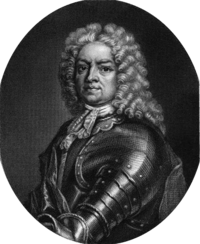 Simon Fraser, 11th Lord Lovat | |
| Tenure | 1699–1746 |
| Predecessor | Thomas Fraser, 10th Lord Lovat |
| Successor | Thomas Fraser, 12th Lord Lovat |
| Other titles | Fraser of Beauclark Jacobite Duke of Fraser, Marquess of Beaufort, Earl of Stratherrick and Upper Tarf, Viscount of the Aird and Strathglass, Lord Lovat and Beaulieu |
| Born | 5 January 1667 |
| Died | 9 April 1747 (aged 80) Tower Hill, London |
| Cause of death | Execution by beheading |
| Nationality | Scottish |
| Spouse(s) | Amelia Murray (disputed) Margaret Grant (died 1726) Primrose Campbell (1710–1796) |
| Issue
General Simon Fraser (1726-1782) Archibald Campbell Fraser (1736-1815) Alexander (1729–1762); Janet (d. 1762); Sybilla | |
| Parents | Thomas Fraser, 10th Lord Lovat Sybilla Macleod (died 1682) |
Early life
Simon was the second son of Thomas Fraser (1631–1699), known as ‘Thomas of Beaufort’. His mother was Sybilla Macleod (d 1682). The Beaufort Frasers were related to Lord Lovat, the chief of the highland Clan Fraser. Simon was tutored privately at his home near Beauly, followed by a period at grammar school in Inverness. He was a capable student, becoming fluent in English, French and Gaelic, as well as gaining a solid grounding in Latin.[1]
His older brother Alexander died from wounds received fighting government forces at the inconclusive Battle of Killiecrankie. Simon, now his father's heir, left home to study at King's College, Aberdeen, where he was a ‘diligent student’[2] and graduated with a Master of Arts degree in 1695.
Issues of inheritance
Upon graduation in 1695 he was at a crossroads, owing to the poor leadership of the clan by Hugh Fraser, 9th Lord Lovat (1666-1696). Recognising the threat posed to it by the expanding power of the nearby Clan Mackenzie, as well as its ally the Atholl Murrays, Simon of Beaufort needed to ensure his father's succession to the lordship. There were two avenues available to him to pursue this claim: the law or the army.[3] He chose the latter. Accordingly, he went to Edinburgh and undertook to recruit three hundred men from his clan to form part of a regiment in the service of William III and Mary II. This was done more to ensure a body of well-trained soldiers under his influence than loyalty to the government.[4] However, a suspicious Lord John Murray (brother of Hugh Fraser's wife, Amelia Murray) was colonel of Simon's regiment and he was only given a lieutenancy, not a salaried captainship.
In early 1696, whilst on a trip to London in the company of both Simon of Beaufort and Lord John Murray, Hugh assigned the succession of the Lovat title to the Beaufort Frasers.[5][6] Hugh died that same year, and Thomas of Beaufort (Simon's father) then took on the title of 10th Lord Lovat, but the succession was to be disputed by Lord John Murray, now the Earl of Tullibardine and the most powerful man in Scotland.
Open violence
After a fierce verbal encounter in Edinburgh, when Tullibardine attempted to make Simon renounce his claim to the lordship,[7] Simon went to Castle Dounie to negotiate with Hugh's widow Amelia for the hand of her young daughter (also called Amelia). Tullibardine responded by removing his niece to Blair Castle, stronghold of the Murrays. It was his intention that she marry Alexander Fraser, heir to Lord Saltoun and unrelated to the highland Frasers.
Simon responded to this by kidnapping the young Master of Saltoun when he arrived in Fraser territory in an attempt win local support for the marriage.[8] By having a gallows built outside the window of his prison and threatening to hang him, Simon successfully dissuaded Alexander from marrying the heiress. Although this incident was characteristic of a private clan feud,[9] Tullibardine had no intention of letting the matter rest. He declared the Frasers had risen in open rebellion against the Crown, and harried the colonel in charge of the government barracks at Fort William to proceed against Fraser.
Before the Crown could respond, however, Simon undertook an act in October 1697 which was to have dire consequences for both himself and others. ‘If he could not have Amelia the daughter, he would have Amelia the mother’.[10] Whilst at Castle Dounie he had an Episcopal minister brought in to marry them. Her family, the most powerful in Scotland, was naturally enraged by this act of violence. He later treated it as a practical joke without legal validity; they separated in December 1697 and he married twice more before Amelia's death on 6 May 1743, without seeking divorce.[11]
Once Simon allowed his wife to rejoin her family at Blair Castle, the Privy Council and Court of Session issued ‘Letters of Intercommuning’, preventing people from ‘communing’ with Simon, his father and any of his followers. Moreover, they could be brought in ‘dead or alive’.[12] A military expedition of both Atholl Murray men and government troops was sent to Fraser country in February 1698 to achieve this, but they failed to capture him. Simon and his father made good their escape to the highlands, and the troops could do little but destroy Fraser property.[13]
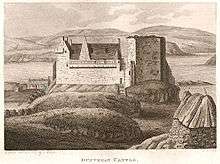
They were eventually cited to answer two charges: forced marriage and rape, as well as raising men in arms. In September 1698– and still notable for their absence– Simon, his father, and twenty leading men of the clan were convicted of the capital crime of rebellion.[14] Eventually Simon and his father took refuge at Dunvegan Castle on Skye. This was the ancestral home to the McLeods, his mother's family. It was here in May 1699 that the 69 year old Thomas died, still with a price on his head. Simon now assumed the title of Lord Lovat, but he was an outlaw and unable to claim his estates. Simon was obliged to bury his father at Dunvegan rather than the traditional burial place of Lovat Frasers, at Wardlaw, near Beauly. (Eventually, on securing the title, he erected a notably extravagant memorial stone at Wardlaw Mausoleum).
Despite these tribulations, Fraser still commanded the loyalty of his clan, not least because of the Atholl Murrays' ‘systematic attempt to ravage the properties of those Fraser gentlemen well disposed to Simon’s cause'.[15] After his return from Skye, Simon Fraser commanded about 300 armed followers and successfully ambushed some 600 Athollmen and government soldiers near Inverness. Simon was dissuaded from massacring them, but two of Tullibardine’s brothers were forced to kiss the tip of his sword. The enemy troop were then made to run the gauntlet.[16] In this, Simon showed he was capable of fulfilling an important role of a highland chief, that of military leader.[17]
Royal pardon
Simon was facing nearly impossible odds in his attempts to gain control of the Fraser lands, and the law offered him no opportunity for recourse. Both Tullibardine and his ally, George Mackenzie, Viscount of Tarbat, had a firm control of the Edinburgh judiciary.[18][19] However, he found a powerful ally in Archibald Campbell, tenth Earl (and after 1701, first Duke) of Argyll and chief of the powerful Clan Campbell. Argyll advised Simon to and go to London and seek a pardon from King William, whilst informing William in a letter of the ‘chaos and hostility’[20] caused by Tullibardine in his pursuit of Simon. Other powerful voices were to support Argyll's opinion, and ultimately this was to sway the King, now concerned to keep the peace in Scotland whilst he fought a war in Flanders. Granted a pardon in 1700, he was at last free to assume the title of Lord Lovat in the ancestral residence at Castle Dounie. Argyll was himself elevated to a Dukedom, and his rise seemed to presage Tullibardine's fall as well as Simon's advancement

This improvement in his fortunes was not to last. The business of the forced marriage and rape was unresolved (it being a matter concerning private individuals, not the Crown), and the Murrays did not relent on this charge. When he failed to appear in court in February 1701 to answer the charge of ‘rapt and hamesucken’,[21] he was again outlawed. This was followed up a year later by more ‘letters of intercommuning’ (known more dramatically as a ‘Commission of Fire and Sword’). In March 1702 William III died, and Queen Anne succeeded to the throne. She favoured Tullibardine, rather than Argyll.
A final blow was received in mid-1702 when Amelia, the 13-year-old daughter of Hugh, the 9th Lord Lovat, married Alexander Mackenzie, who took the name ‘Alexander Mackenzie of Fraserdale’. This supposedly made him a Fraser, and by the terms of Hugh's marriage contract of 1685, his first born son would inherit the title and estates of Lovat. The Mackenzie takeover of Fraser lands was very close to fruition.[22] The newly married couple moved into Castle Dounie while Simon was in London, seeking to meet the new Queen. On Argyll's advice, Lovat left Britain and headed to a place that might offer a solution to the ongoing issue of his inheritance: the court of the exiled Stuarts, at St Germain-en-Laye in France.
At the court of exiles
After 15 years of exile, the family of James II was still hoping to regain the thrones of England and Scotland. The elder James had died a few months before Simon's arrival, but his 14-year-old son James stood ready. However, the court-in-exile was divided into two factions. One, headed by the Earl of Middleton (‘good tempered, affable and patient’[23]) favoured a peaceful accession by young James to the throne of England on the death of Anne. The other faction was headed by the Duke of Perth (‘proud and passionate’[24]) which saw an armed rising in Scotland, assisted materially by France, as the most likely way to restore the family to its former glory. Simon gravitated towards the Duke of Perth's faction, not least because Simon's cousin, John McLean, already belonged to it.
One major step Fraser took to advance his cause was to convert to Catholicism. The court was ostentatiously Catholic, with James’ mother Mary of Modena setting the standard for piety, and Middleton had himself recently converted. Once a Catholic, Simon was also able to secure a private audience with the King of France, Louis XIV, at Versailles. Here, speaking in 'good French with a Scots accent’[25] he put forward a plan for a rising by the Jacobite clans of the highlands, aided by French troops, arms and money. Later, he added flesh to these plans. About five thousand French troops would land on the east coast of Scotland, at Dundee. At the same time, five hundred men were to land on the west coast and seize Fort William or Inverlochy. Together, they would march towards Edinburgh, gathering men from the clans as they progressed. The involvement of the highlanders was ‘the main and the novel feature’[26] of Simon's plan. It has also been suggested by later writers[27][28] that this plan would form the basis of both major Jacobite uprisings, in 1715 and 1745.
Although the Jacobite ruling council ultimately agreed to the plan, Middleton was cautious and recommended to Louis that Fraser be sent back to Scotland to obtain written proof that the highland clans would rise if French troops landed. So, after a year in France, Simon returned to Scotland in mid-1703 to lay the groundwork for an invasion and uprising which could allow him to reclaim his title and estates.
Double dealings
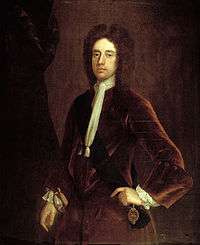
In 1703, Fraser returned to Britain with a handful of blank commissions signed by James Francis Edward, escorted by Lord John Murray, soon to be Duke of Atholl. He first visited London, then Scotland, where he learned that while economic hardships caused considerable discontent with Queen Anne's government, the Highland chiefs were unenthusiastic about another rising.[29] In September, he met Anne's representative in the Scottish parliament, James Douglas, Duke of Queensberry and shared details of the French invasion plans. He also showed him a letter from Mary of Modena, addressed to an ‘L. J. M.’ which he suggested was Lord John Murray; these initials were probably added by Fraser himself.[30]
Fraser's goal was to regain the Lovat title and estates; while his brother John tried to keep his clansmen loyal and collected rents in his absence, there were signs they were beginning to accept a Mackenzie in his place. Later evidence suggests his betrayal of the Stuart cause was an attempt to implicate his political enemies Atholl and Queensbury in a Jacobite plot.[31] In the absence of a successful rising, this would ensure his political rehabilitation by ingratiating himself with the existing government.[32]
As the main Scottish sponsor of Union, Queensberry was happy to implicate the anti-Union Atholl and passed this onto London. and provided Fraser a passport under a false name allowing him to leave the country. With rumours already circulating about Fraser's return and calls being made for his capture, Queensbury provided him with a passport in a false name and he was obliged to return to France to explain himself.
Imprisonment in France
On his return in late 1703, Lovat prepared a report to Mary of Modena summarising Jacobite support in Scotland, which actually appeared favourable for her son's return to the throne. After an initially warm response, news of his double dealings reached Paris. King Louis XIV responded initially by sending Lovat into exile in the middle of France, at Bourges. Misjudging the extent to which he was out of favour, he used a gratuity and a pension from the French King to help pay for lavish celebrations in the city in recognition of French military successes. Louis responded by sending him to prison at Angoulême where he was to remain, unable to influence events, for the next three years. In 1707 he was moved to the town of Saumur. He was not in prison, and able to correspond and see visitors, but he was not allowed to visit Paris or Scotland.
Return to Britain and the 1715 rebellion
As late as 1714, many Fraser gentry had still not accepted Alexander Mackenzie as their chief, even though he was married to the heiress and was living at Castle Dounie. A group of Fraser gentlemen sent one of their own, James Fraser of Castle Leathers, to Saumur in order to bring Simon back home. After some hesitation by Simon, they returned to Britain via Dover. He then bided his time in London in order to determine his legal status.
At this point, political events again overtook Fraser's life. The childless Queen Anne died just before his return to Britain and was succeeded by George of Hanover. In response, a Jacobite rebellion broke out in Scotland in September 1715, led by the Earl of Mar. Seeing his opportunity for redemption, Lovat secured permission to return to Scotland and help rally the Fraser clansmen for the government.
After an arduous trip north, Fraser finally met up with his loyal clansmen outside of Inverness, which had been occupied by Jacobite troops. The Clan Mackenzie had already declared for the Stuart King in France, and several hundred Fraser men had joined them under the Earl of Seaforth. But ‘when they heard I was in my country’, he claimed, 'they ‘made a great desertion in Mar’s army’.[33] Fraser's ‘energy and tactical acuity’[34] certainly reinvigorated the government's campaign in the north, and by helping ensure no reinforcements arrived, he expedited the surrender of Inverness by its Jacobite garrison on 12 November 1715.
Restoration of the title and estates
For his efforts, which included securing the surrender of the Earl of Seaforth, Fraser secured a full pardon from the King in March 1716.[35] He was now able to occupy Castle Dounie as the 11th Lord Lovat without fear of arrest or execution. Another concession by the King later that year meant that he could also claim the income from the estates, although only for the lifetime of the previous tenant, Alexander Mackenzie (now languishing in a jail in Carlisle after having risen for the Jacobites). In a further sign of his restoration to respectability, Lovat was also appointed Governor of the Castle at Inverness and given command of his own Company of Foot.
The rest of Simon's life involved untangling the legal and financial problems he had inherited with the title, as well as fending off lawsuits from various claimants in the courts (one writer suggests he may even have enjoyed them).[36] One notable legal dispute was with Alexander Mackenzie (who had been pardoned for his rebellion in 1715) over the income of the estates, which dragged through the courts until the 1730s. It was only then, with the payment of a crippling sum of money as compensation, that Simon stood in undisputed possession of his title and estates.[37]
Lovat as Clan Chief
Lovat had a medieval conception of the role of clan chief. He had little patience for those leading clansmen who disagreed with him, and he quarrelled furiously with men such as Alexander Fraser of Phopachy and James Fraser of Castle Leathers. His relations with lesser clansmen were marked by a paternal interest in their affairs.
Generally he had a bag of farthings for when he walked abroad the contents of which he distributed among any beggars whom he met. He would stop a man on the road; inquire how many children he had; offer him sound advice; and promise to redress his grievances if he had any’[38]
In his own estimate, he took care his clansmen were ‘always well-clothed and well-armed, after the Highland fashion, and not to suffer them to wear low-country clothes’.[39] In return he kept a lavish table at his (smallish) castle, with a ‘great abundance of all kinds of meat – and drink’.[40] As a recent biographer notes, it was really a redistribution of the rent he had collected from the clansmen.[41]
Family
With Lovat's forced marriage with Amelia Murray in 1697 conveniently being forgotten, he married Margaret Grant in 1717. This marriage, ‘the most successful of Lovat’s matrimonial experiences’.[42] produced three girls (Georgina, Janet, Sibyl) and two boys (Simon and Alexander). Simon, born 1726, became Master of Lovat. Margaret died in 1729 and he married the 23 year old Primrose Campbell four years later. This produced one child, Archibald, but the marriage was not a happy one and they separated in 1738.
Lady Lovat was forced to live in seclusion at Castle Downey after his execution, but although officially stripped of her title was still broadly referred to as "Lady Lovat". Archibald Fraser became a merchant in London.[43]
Jacobite sympathies
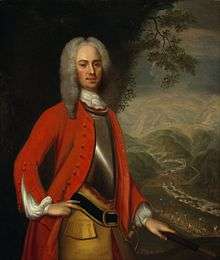
Jacobite ideology emphasised obedience to social superiors and traditional structures; in Scotland, it was particularly strong among clan leaders and Non-Juring Episcopalians.[44] It has been suggested Lovat was "always a Jacobite" and his loyalty to the London government simply a means to an end, the retention or recovery of his title and estates.[45] The evidence suggests that like many contemporaries, Lovat's support for both the Stuarts and their rivals depended on which one he considered more advantageous for his personal ends. It is hard to discern a more consistent thread than that of pure self-interest.[46]
After the failed 1719 Rising, the government concluded the Highlands could only be governed with the co-operation of the clan chiefs or heritors.[47] Many Jacobite exiles accepted pardons and returned home, including William Mackenzie, Earl of Seaforth, which threatened Lovat's influence with the government.
In a memorial of 1724, he emphasised the role of the Independent Highland Companies in controlling the Highlands; these had been disbanded in 1717, depriving him of an important source of both power and income.[48] George Wade was sent to Scotland in 1724 to assess these proposals and approved the establishment of six new Independent Companies, one commanded by Lovat. Wade also recommended building new fortresses, linked by an extensive military road network; in 1725, he was appointed Commander in Chief, Scotland tasked with carrying out his own recommendations.[49] These developments threatened to undercut the influence of the traditional Highland chiefs and were far less welcome.[50]
In the early 1730s, Lovat fell out with his Whig allies, including Argyll and Duncan Forbes and by 1737, he had resumed contact with the Stuart exiles. In 1739, James' offer of a dukedom was enough to gain his support for forming the Jacobite Association, with several other leading men of Scotland.[51] Aware of these moves, in 1740 the government removed him from command of his Independent Company; for reasons best known to Lovat, he deemed this a bitter insult.[52]
"The '45"

On 23 July 1745, Charles Edward Stuart landed at Eriskay, much to the dismay of the Scots who had previously urged him not to do so unless he also brought French troops, weapons and money. Many of those contacted advised him to return to France, including MacDonald of Sleat and Norman MacLeod.[53] Lovat sent messages of support to both sides and maintained contact with Duncan Forbes, who hoped to ensure his neutrality; until then, there were men drilling on his green ‘but only he knew why, and the law’s arm was restrained till he should be forced to declare his choice’.[54]
Lovat's options were complicated by the fact the senior Jacobite leaders included his long-term enemies Lord George Murray and Tullibardine. After victory at Prestonpans in September, he solved this by ordering his son Simon, Master of Lovat to join the Jacobites. While Simon was a political Whig who allegedly considered the Rising nonsensical, a contemporary noted his father was a 'very strict man' with great power over his children.[55] Acting on instructions from Lovat, on 16 October the Frasers attempted to kidnap Duncan Forbes from his home and attacked Fort Augustus in early December. Finally losing patience, Loudon arrested Lovat at Castle Dounie and took him to Inverness; on 2 January, he escaped without difficulty and was transported by Fraser clansmen to Gorthleck House, overlooking Loch Ness.[56]
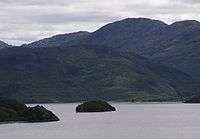
Only some of the Fraser regiment was present at Culloden in April 1746; like many others, the main part under the Master of Lovat returned only at daybreak, exhausted from an ill-fated night march and missed the battle. One of the few elements of the Jacobite centre to retire in good order, the Frasers withdrew towards Inverness, where it met the rest of their unit.[57]
Charles was escorted from the battle field to Gorthleck House, where he met Lovat, who advised him to regroup in the hills.[58] The next morning they went their separate ways; Lovat was rowed across Loch Ness but his escape was hampered by a combination of gout and arthritis which meant he had to be carried on a litter. During the post-Culloden search for Jacobites, John Ferguson, commander of the Royal Navy vessel Furnace, received information Lovat was hiding on the island of Loch Morar, where he was arrested on 7 June.[59]
Brought to London for trial, one of his stops was at St Albans, where he was sketched by William Hogarth; this shows him listing points on his fingers, although what these were is uncertain.[60]
Trial and execution
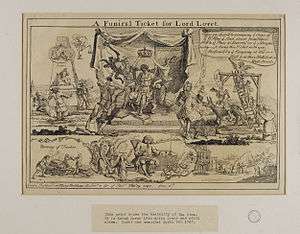
Lodged in the Tower of London, Simon awaited his trial for high treason which began in March 1747. The trial at Westminster Hall took seven days, with the first five consisting of evidence against the accused. On the sixth day he spoke in his defence, but the result was a foregone conclusion, and the guilty verdict passed at the end of the day. On the final day, his punishment of a traitor's death by hanging, drawing and quartering was announced, which was later commuted by the King to beheading.
He remained sanguine in the days leading up to the execution, even exhibiting a sense of humour. The day of his execution, 9 April 1747, saw many spectators arrive at Tower Hill, and an overcrowded timber stand collapsed, leaving nine spectators dead, to Lovat's wry amusement.[61] Among his last words was a line of Horace: Dulce et decorum est pro patria mori. (It is sweet and seemly to die for one's country). He died, in his own eyes, as a Scottish patriot.
Burial

The government originally agreed that Lovat could be buried at the family mausoleum at Wardlaw near Inverness.[62] In the end, it was decided to follow standard practice for those executed on Tower Hill; Lovat and the two other Jacobite peers, Kilmarnock and Balmerino, were interred in St Peter ad Vincula, the chapel attached to the Tower of London. When it was refurbished in the 19th century, one of the coffins uncovered bore the nameplate ‘Lord Lovat;’ his name now appears on a plaque on the wall of the chapel.
For over 250 years, family tradition claimed his body was secretly removed and interred in the mausoleum.[63] A lead-covered coffin in the crypt bore a bronze nameplate in the name of Sir Simon Fraser, with a Latin inscription; thought to have been dictated by Lovat himself, it refers to "the tyranny of the Athol and the treacherous plotting of the Mackenzies of Tarbat."[lower-alpha 1]
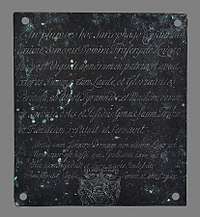
However, an analysis of the bones within the coffin carried out in 2018 by the University of Dundee showed they belonged to a young woman, not Simon Fraser.[65] One suggestion is the coffin was prepared for Lovat, hence the nameplate, but when the government changed its mind, it was sent to Wardlaw anyway; investigations continue.[66]
At the bottom of the plaque is an engraving of the Lovat Coat of Arms. However instead of a baron's coronet there is a ducal one. In 1740, Lovat was created Duke of Fraser, Marquess of Beaufort, Earl of Stratherrick and Upper Tarf, Viscount of the Aird and Strathglass and Lord Lovat and Beaulieu in the Jacobite Peerage of Scotland by James Francis Edward Stuart, soi disant James III of England and VIII of Scotland.
Next to his coffin are those of his two sons, General Simon Fraser (1726-1782) and Archibald Campbell Fraser (1736-1815), Archibald's wife Jane and two of their children Henry Emo Fraser and John George Hugh Fraser. Archibald's children all predeceased him and by his request the estate passed to Thomas Alexander Fraser of Strichen in Aberdeenshire, from whom the current Lovat Fraser family descends.
In fiction
Simon Fraser, 11th Lord Lovat, features as a character in Diana Gabaldon's 1992 novel Dragonfly in Amber, the second novel in her Outlander series. In it, Lovat is the grandfather of Jamie Fraser. Lovat is played by Clive Russell in series 2 of the television series Outlander.
Fraser is also a major character in "A Lost Lady of Old Years" by John Buchan and the 1914 historical thriller The New Road by Neil Munro.
See also
Notes
- In this coffin are laid the remains of Simon Lord Fraser of Lovat who, after twenty years in His own Land and abroad with the greatest distinction and renown, at the risk of his own life, restored and preserved his race, clan and household from the tyranny of the Athol and the treacherous plotting of the Mackenzies of Tarbat. To preserve an ancient house is not the greatest credit. Nor is there any honour for the enemy who despoiled it. Although that enemy was strong in his plotting and unrelenting warfare, yet Simon who was also skillful and cunning defeated him in war.[64]
References
- Fraser, Sarah (2012). The Last Highlander. p. 9.
- Mackenzie (1908). Simon Fraser, Lord Lovat. His Life and Times. p. 6.
- Mackenzie (1908). Simon Fraser, Lord Lovat. His Life and Times. p. 11.
- Fraser (2012). The Last Highlander. p. 33.
- Fraser (2012). The Last Highlander. p. 39.
- Oxford Dictionary of National Biography Vol 20. 2004. p. 863.
During the trip Fraser suborned Lovat into disinheriting his daughter Amelia and granting the estates and title to his father.
- Fraser (2012). The Last Highlander. pp. 42–44.
- Lenman (1984). The Jacobite Clans of the Great Glen. p. 61.
- Fraser (2012). The Last Highlander. p. 49.
- Fraser (2012). The Last Highlander. p. 52.
- Furgol, Edward M (2010). Fraser, Simon, eleventh Lord Lovat. 1 (Online ed.). Oxford BNB. doi:10.1093/ref:odnb/10122.
- Burton (1847). Lives of Simon Lord Lovat and Duncan Forbes of Culloden. p. 37.
- Fraser (2012). The Last Highlander. p. 57.
- Lenman (1984). The Jacobite Clans of the Great Glen. p. 65.
'Such a trial, in the absence of the accused, was almost certainly technically illegal'.
- Lenman (1984). The Jacobite Clans of the Great Glen. p. 66.
- Fraser (2012). The Last Highlander. pp. 60–61.
- Bold, Alan (1973). Scottish Clans. p. 6.
- Fraser (2012). The Last Highlander. pp. 62–63.
- Lenman (1984). The Jacobite Clans of the Great Glen. p. 66.
- Fraser (2012). The Last Highlander. p. 63.
- Fraser (2012). The Last Highlander. p. 67.
...rapt was a watered- down assault... Hamesucken...was socking(sucken)it to someone in their own home (hame)
- Lenman (1984). The Jacobite Clans of the Great Glen. p. 68.
The Mackenzies were openly moving to establish another branch of their clanned power
- Mackenzie (1908). Simon Fraser, Lord Lovat. His Life and Times. p. 86.
- Mackenzie (1908). Simon Fraser, Lord Lovat. His Life and Times. p. 86.
- Fraser (2012). The Last Highlander. p. 83.
- Burton (1847). Lives of Simon, Lord Lovat and Duncan Forbes of Culloden. p. 60.
- Burton (1847). Lives of Simon, Lord Lovat and Duncan Forbes of Culloden. p. 62.
- Fraser (2012). The Last Highlander. p. 87.
- Lord, Evelyn (2004). The Stuarts' Secret Army. Pearson. p. 34. ISBN 978-0582772564.
- Mackay (ed) (1911). Trial of Simon, Lord Lovat of the '45. p. Introduction: xxii.CS1 maint: extra text: authors list (link)
- Lord, Evelyn (2004). The Stuarts' Secret Army. Pearson. p. 34. ISBN 978-0582772564.
- Mackenzie (1908). Simon Fraser, Lord Lovat. His Life and Times. pp. 114–115.
- Mackenzie (1908). Simon Fraser, Lord Lovat. His Life and Times. p. 249.
- Fraser (2012). The Last Highlander. p. 157.
- Mackenzie (1908). Simon Fraser, Lord Lovat. His Life and Times. p. 264.
- Mackay, David (1911). Trial of Simon, Lord Lovat of the '45. p. Introduction: xli.
- Fraser (2012). The Last Highlander. p. 237.
- Mackenzie (1908). Simon Fraser, Lord Lovat. His Life and Times. p. 301.
- Mackenzie (1908). Simon Fraser, Lord Lovat. His Life and Times. p. 278.
- Mackenzie (1908). Simon Fraser, Lord Lovat. His Life and Times. p. 303.
- Robinson, David (5 May 2012). "Interview: Sarah Fraser, author of The Last Highlander". The Scotsman. Retrieved 2 March 2016.
- Mackay (1911). Trial of Lord Lovat of the '45. p. Introduction: xli.
- FGrants Old and New Edinburgh vol II p.256
- MacInnes, Allan I (2007). "Jacobitism in Scotland: Episodic Cause or National Movement?". The Scottish Historical Review. 86 (222): 233. JSTOR 25529981.
- Fraser, Sarah (2012). The Last Highlander. pp. 244, 351.
- Furgol, Edward (2010). Fraser, Simon, eleventh Lord Lovat. 1 (Online ed.). Oxford DNB. doi:10.1093/ref:odnb/10122.
- Szechi, Daniel, Sankey, Margaret (November 2001). "Elite Culture and the Decline of Scottish Jacobitism 1716-1745". Past & Present. 173 (173): 108 passim. JSTOR 3600841.
- Furgol, Fraser, Simon, eleventh Lord Lovat
- "No. 6371". The London Gazette. 8 May 1725. p. 1.
- Fraser (2012). The Last Highlander. p. 217.
- Fraser, p. 248
- Mackay (1911). Trial of Simon, Lord Lovat of the '45. p. Introduction: xlv.
- Riding, Jacqueline (2016). Jacobites: A New History of the 45 Rebellion. Bloomsbury. pp. 83–84. ISBN 978-1408819128.
- Mackay (1911). Trial of Simon, Lord Lovat of the '45. p. Introduction: xlviii.
- Mackenzie (1896). History of the Frasers of Lovat. p. 425.
- Fraser (2012). The Last Highlander. p. 302.
- Fraser, pp.316–317
- Fraser, p.322
- Riding, p. 462
- Fraser (2012). The Last Highlander. p. 338.
It might have been the number of clans who would rise and rebel. It might have been the men he could count on subverting. It was any old argument from a man who had spent his life in debate.
- Fraser (2012). The Last Highlander. p. Prologue: xxiii.
- "Wardlaw Mausoleum". Wardlawmausoleum.com. Retrieved 24 April 2019.
- Anderson (1825). The Historical Account of the Family of Frisel or Fraser particularly Fraser of Lovat. Edinburgh. p. 155.
- Fraser of Wardlaw (1966). Lovat of the '45 – The Final Chapter. p. 20.
- https://www.theguardian.com/science/2018/jan/19/headless-body-is-not-scottish-clan-chief-simon-fraser-experts
- Lundberg, Erik. "Results of Bone Analysis on the headless lady in the coffin". Wardlaw Mausoleum. Retrieved 24 April 2019.
Bibliography
- Bold, Alan (1973) Scottish Clans. Garrod & Lofthouse Ltd, Crawley.
- Burton, John Hill (1847) Lives of Simon Lord Lovat and Duncan Forbes of Culloden. Chapman and Hall, London.
- Devine, T.M (2006) The Scottish Nation 1700-2007. Penguin Books, London. ISBN 978-0-141-02769-2
- Fraser, Sarah (2012) The Last Highlander. Scotland's Most Notorious Clan Chief, Rebel and Double Agent. Harper Collins, London. ISBN 978-0-00-722949-9
- 'Fraser, Simon, eleventh Lord Lovat' in Oxford Dictionary of Biography Volume 20 (1984) Oxford University Press. ISBN 0-19-861370-9
- Lenman, Bruce (1984) The Jacobite Clans of the Great Glen 1650-1784 Methuen, London. ISBN 0-413-48690-7
- Mackay, D.N. (1911) Trial of Simon, Lord Lovat, of the '45. Hodge, Edinburgh. (Series: Great British Trials)
- Mackenzie, W.C (1908) Simon Fraser, Lord Lovat. His Life and Times. Chapman and Hall, London.
- Oliver, Neil (2009) A History of Scotland. Weidenfeld & Nicolson, London. ISBN 978-0-7538-2663-8

- Prebble, John (1996) [1961]. Culloden. Penguin Books. ISBN 978-0-14-025350-4.
- Ross, David (2005) England. History of a Nation. Geddes & Grosset, New Lanark ISBN 1 84205 319 1
External links
| Peerage of Scotland | ||
|---|---|---|
| Preceded by Thomas Fraser |
Lord Lovat 1699–1747 |
Succeeded by Thomas Alexander Fraser |
| Honorary titles | ||
| Preceded by Thomas Fraser |
MacShimidh 1699–1747 |
Succeeded by Simon Fraser of Lovat |
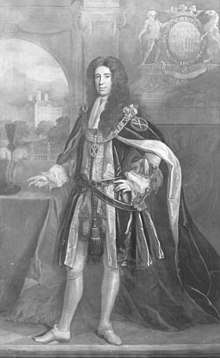
.svg.png)